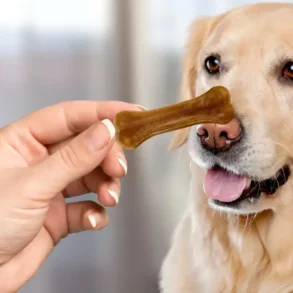A dog’s diet is simultaneously the simplest and most difficult thing to master.
They’ll eat anything we give them, so we could choose whatever dog food we want. Then again, they’ll eat anything we give them, so they’re counting on us to make sure it’s the best stuff.
As our furry friends go from little to big, and cute to cuter, it gets more and more important to ensure we nail their nutrition for long-term health and vitality.
We asked Dr Leoti Morkel, Technical Services Veterinarian at MasterPet, just how we can get it right.
What you need to know about canine nutrition
First and foremost, Dr Morkel says our dogs’ diets need to be complete and balanced.
“That basically means it contains all the essential nutrients like proteins, fats, vitamins, and minerals that a dog needs not only to survive but to thrive,” she says.
These include calcium and phosphorus for strong bones and proteins for strong muscles. Omega-3s for vision, biotin for a silky coat and antioxidants for their immune system.
And don’t forget about taste.
“It doesn’t matter how nutritious a diet is, if a dog doesn’t find it appealing or struggles to eat it, you won’t get the full benefits of those nutrients,” says Dr Morkel.
She recommends choosing a high-quality kibble that is easy to digest, which means less discomfort for your dog (and less of their flatulence for you to deal with).
As your dog gets older, you can start to introduce functional ingredients like glucosamine and chondroitin to support their joints and motility.
“Then something that we are quite passionate about is prebiotics and probiotics,” Dr Morkel explains. “Prebiotics are the food for the good bacteria in the gut. And probiotics are the live microorganisms we provide.”
A healthy gut microbiome needs good quality prebiotic fibres like sweet potato and beet pulp to feed the beneficial bacteria. This helps improve digestion and nutrient absorption for a happy healthy dog.
The simple way to give your dog what they need
Of course, there’s an easy formula to follow to make sure you do right by your dog.
“As they age, you should give them an age-appropriate diet,” says Dr Morkel.
“When they’re a puppy, they should be on a puppy diet, when they’re a large breed puppy, they should be on a puppy diet that supports a large breed puppy… When they’re adults, they should be on an adult diet.”
Most dog foods are easily labeled according to each age range, making the trip to the grocery store particularly easy.
VitaPet, for example, has a Junior range specifically formulated for large breed puppies and smaller breed pups from six months to two years old. They also have puppy and adult food, along with well-balanced treats.
Dr Morkel says a good way to check the quality of the food is to make sure it’s formulated according to the AAFCO guidelines. These guidelines define the minimum nutritional requirements pet food must meet for different life stages, ensuring it provides a complete and balanced diet.
Another good tip is to make sure it has ingredients you recognise.
“High-quality ingredients are important to look for,” says Dr. Morkel. “Proteins like chicken, beef, and lamb are common animal sources, and they’re usually easy for dogs to digest.”
You can also cross check it has all those key nutrients Dr Morkel mentioned. And when you’re there, don’t forget the wet food.
“Just like us humans, dogs get bored with the same food day after day,” Dr Morkel says. “Wet food and dry foods have different textures, flavours and smells so it can stimulate their appetite and encourage them to eat.”
So, sure, our dogs might just eat anything—shoes included. But it’s heartening to know it’s not difficult to give them what they really need to live a long and healthy life.
VitaPet has you covered at all stages of your dog’s life—and is now available at your local Coles and Woolworths. With high-quality, all-natural food formulated for puppies, junior dogs and adults, VitaPet is Food4Life.
This post was originally published on this site be sure to check out more of their content.







































